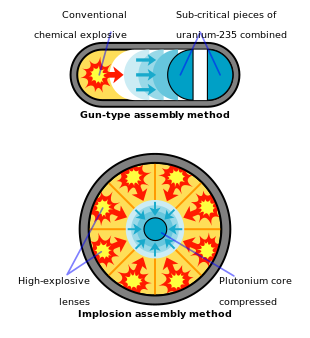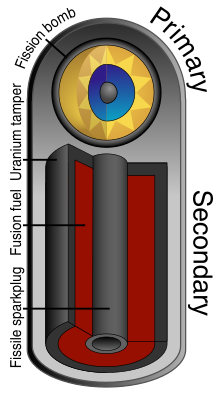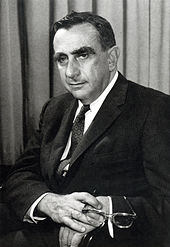SOURCE:
https://en.wikipedia.org/wiki/Nuclear_weapon
PART - 1 of 3
****************************************
CLICK TO READ
( A ) PART ONE of THREE PARTS -
http://bcvasundhra.blogspot.in/2016/01/nukes-nuclear-weapon.html
( B ) PART TWO of THREE PARTS -
http://bcvasundhra.blogspot.in/2016/01/nukes-nuclear-weapons.html
( C ) PART THREE of THREE PARTS -
http://bcvasundhra.blogspot.in/2016/01/source-non-weapons-uses-main-article.html
NUCLEAR WEAPONS
From Wikipedia, the free encyclopedia
A-bomb" redirects here.
For other uses, see A-bomb (disambiguation).

The mushroom cloud of the atomic bombing of the Japanese city of Nagasaki on August 9, 1945 rose some 11 miles (18 km) above the bomb's hypocenter.
https://en.wikipedia.org/wiki/Nuclear_weapon
PART - 1 of 3
****************************************
CLICK TO READ
( A ) PART ONE of THREE PARTS -
http://bcvasundhra.blogspot.in/2016/01/nukes-nuclear-weapon.html
( B ) PART TWO of THREE PARTS -
http://bcvasundhra.blogspot.in/2016/01/nukes-nuclear-weapons.html
( C ) PART THREE of THREE PARTS -
http://bcvasundhra.blogspot.in/2016/01/source-non-weapons-uses-main-article.html
NUCLEAR WEAPONS
From Wikipedia, the free encyclopedia
A-bomb" redirects here.
For other uses, see A-bomb (disambiguation).

A nuclear weapon is an explosive device that derives its destructive force from nuclear reactions, either fission (fission bomb) or a combination of fission and fusion (thermonuclear weapon). Both reactions release vast quantities of energy from relatively small amounts of matter. The first fission ("atomic") bomb test released the same amount of energy as approximately 20,000 tons of TNT (see Trinity (nuclear test)). The first thermonuclear ("hydrogen") bomb test released the same amount of energy as approximately 10,000,000 tons of TNT.[1]
| Nuclear weapons |
|---|
 |
| Background |
| Nuclear-armed states |
|
| Weapons of mass destruction |
|---|
 |
| By type |
|
| By country |
|
| Proliferation |
| Treaties |
A thermonuclear weapon weighing little more than 2,400 pounds (1,100 kg) can produce an explosive force comparable to the detonation of more than 1.2 million tons (1.1 million tonnes) of TNT.[2] A nuclear device no larger than traditional bombs can devastate an entire city by blast, fire, and radiation. Nuclear weapons are considered weapons of mass destruction, andtheir use and control have been a major focus of international relations policy since their debut.
Nuclear weapons have been used twice in nuclear warfare, both times by the United States against Japan near the end ofWorld War II. On August 6, 1945, the U.S. Army Air Forces detonated a uranium gun-type fission bomb over the Japanese city of Hiroshima; three days later, on August 9, the U.S. Army Air Forces detonated a plutonium implosion-type fission bomb codenamed "Fat Man" over the Japanese city of Nagasaki. The bombings resulted in the deaths of approximately 200,000civilians and military personnel from acute injuries sustained from the explosions.[3] The ethics of the bombings and their role in Japan's surrender remain the subject of scholarly and popular debate.
Since the atomic bombings of Hiroshima and Nagasaki, nuclear weapons have been detonated on over two thousand occasions for the purposes of testing and demonstration. Only a few nations possess such weapons or are suspected of seeking them. The only countries known to have detonated nuclear weapons—and acknowledge possessing them—are (chronologically by date of first test) the United States, the Soviet Union (succeeded as a nuclear power by Russia), the United Kingdom, France, the People's Republic of China, India, Pakistan, and NorthKorea. Germany, Italy, Turkey,Belgium and the Netherlands are NATO nuclear weapons sharing states. Israel is also believed to possess nuclear weapons, though in a policy of deliberate ambiguity, it does not acknowledge having them.[4][5][6] One state, South Africa, fabricated nuclear weapons in the past, but as its apartheid regime was coming to an end, it disassembled its arsenal, acceded to the Nuclear Non-Proliferation Treaty, and accepted full-scope international safeguards.[7] Following the fall of the Soviet Union, the former soviet republics of Belarus, Kazakhstan and Ukraine inherited nuclear weapons. They were all transferred to Russia. The Federation of American Scientists estimated there were more than 15,700 nuclear warheads worldwide as of 2015, with around 4,100 of them considered "operational" (ready for immediate use).[8]
- 1Types
- 2Weapons delivery
- 3Nuclear strategy
- 4Governance, control, and law
- 5Controversy
- 6Costs and technology spin-offs
- 7Non-weapons uses
- 8See also
- 9Notes and references
- 10Bibliography
- 11External links
Types
Main article: Nuclear weapon design
There are two basic types of nuclear weapons: those that derive the majority of their energy from nuclear fission reactions alone, and those that use fission reactions to begin nuclear fusion reactions that produce a large amount of the total energy output.Fission weapons
All existing nuclear weapons derive some of their explosive energy from nuclear fission reactions. Weapons whose explosive output is exclusively from fission reactions are commonly referred to as atomic bombs oratom bombs (abbreviated as A-bombs). This has long been noted as something of a misnomer, as their energy comes from the nucleus of the atom, just as it does with fusion weapons.In fission weapons, a mass of fissile material (enriched uranium or plutonium) is assembled into a supercritical mass—the amount of material needed to start an exponentially growing nuclear chain reaction—either by shooting one piece of sub-critical material into another (the "gun" method) or by compressing using explosive lenses a sub-critical sphere of material using chemical explosives to many times its original density (the "implosion" method). The latter approach is considered more sophisticated than the former and only the latter approach can be used if the fissile material is plutonium.A major challenge in all nuclear weapon designs is to ensure that a significant fraction of the fuel is consumed before the weapon destroys itself. The amount of energy released by fission bombs can range from the equivalent of just under a ton of TNT, to upwards of 500,000 tons (500 kilotons) of TNT.[9]All fission reactions necessarily generate fission products, the radioactive remains of the atomic nuclei split by the fission reactions. Many fission products are either highly radioactive (but short-lived) or moderately radioactive (but long-lived), and as such are a serious form of radioactive contamination if not fully contained. Fission products are the principal radioactive component of nuclear fallout.The most commonly used fissile materials for nuclear weapons applications have been uranium-235 and plutonium-239. Less commonly used has been uranium-233. Neptunium-237 and some isotopes of americium may be usable for nuclear explosives as well, but it is not clear that this has ever been implemented, and even their plausible use in nuclear weapons is a matter of scientific dispute.[10]Fusion weapons
Main article: Thermonuclear weapon
The other basic type of nuclear weapon produces a large proportion of its energy in nuclear fusion reactions. Such fusion weapons are generally referred to as thermonuclear weapons or more colloquially as hydrogen bombs (abbreviated asH-bombs), as they rely on fusion reactions between isotopes of hydrogen (deuterium and tritium). All such weapons derive a significant portion, and sometimes a majority, of their energy from fission. This is because a fission reaction is required as a "trigger" for the fusion reactions, and the fusion reactions can themselves trigger additional fission reactions.[11]Only six countries—United States, Russia, United Kingdom, People's Republic of China, France and India—have conducted thermonuclear weapon tests. (Whether India has detonated a "true", multi-staged thermonuclear weapon is controversial.)[12] North Korea claims to have tested a fusion weapon as of January 2016, though this claim is disputed.[13]Thermonuclear weapons are considered much more difficult to successfully design and execute than primitive fission weapons. Almost all of the nuclear weapons deployed today use the thermonuclear design because it is more efficient.[citation needed]Thermonuclear bombs work by using the energy of a fission bomb to compress and heat fusion fuel. In the Teller-Ulam design, which accounts for all multi-megaton yield hydrogen bombs, this is accomplished by placing a fission bomb and fusion fuel (tritium, deuterium, or lithium deuteride) in proximity within a special, radiation-reflecting container. When the fission bomb is detonated, gamma rays and X-rays emitted first compress the fusion fuel, then heat it to thermonuclear temperatures. The ensuing fusion reaction creates enormous numbers of high-speed neutrons, which can then induce fission in materials not normally prone to it, such as depleted uranium. Each of these components is known as a "stage", with the fission bomb as the "primary" and the fusion capsule as the "secondary". In large, megaton-range hydrogen bombs, about half of the yield comes from the final fissioning of depleted uranium.[9]Virtually all thermonuclear weapons deployed today use the "two-stage" design described above, but it is possible to add additional fusion stages—each stage igniting a larger amount of fusion fuel in the next stage. This technique can be used to construct thermonuclear weapons of arbitrarily large yield, in contrast to fission bombs, which are limited in their explosive force. The largest nuclear weapon ever detonated—the Tsar Bomba of the USSR, which released an energy equivalent of over 50 million tons (50 megatons) of TNT—was a three-stage weapon. Most thermonuclear weapons are considerably smaller than this, due to practical constraints from missile warhead space and weight requirements.[14]Fusion reactions do not create fission products,and thus contribute far less to the creation of nuclear fallout than fission reactions, but because all thermonuclear weapons contain at least one fission stage, and many high-yield thermonuclear devices have a final fission stage, thermonuclear weapons can generate at least as much nuclear fallout as fission-only weaponsOther types
Main articles: boosted fission weapon, neutron bomb and radiological bombThere are other types of nuclear weapons as well. For example, a boosted fission weapon is a fission bomb that increases its explosive yield through a small amount of fusion reactions, but it is not a fusion bomb. In the boosted bomb, the neutrons produced by the fusion reactions serve primarily to increase the efficiency of the fission bomb.Some weapons are designed for special purposes; a neutron bomb is a thermonuclear weapon that yields a relatively small explosion but a relatively large amount of neutron radiation; such a device could theoretically be used to cause massive casualties while leaving infrastructure mostly intact and creating a minimal amount of fallout. The detonation of any nuclear weapon is accompanied by a blast of neutron radiation. Surrounding a nuclear weapon with suitable materials (such as cobalt or gold) creates a weapon known as a salted bomb. This device can produce exceptionally large quantities of radioactive contamination.Research has been done into the possibility of pure fusion bombs: nuclear weapons that consist of fusion reactions without requiring a fission bomb to initiate them. Such a device might provide a simpler path to thermonuclear weapons than one that required development of fission weapons first, and pure fusion weapons would create significantly less nuclear fallout than other thermonuclear weapons, because they would not disperse fission products. In 1998, the United States Department of Energy divulged that the United States had, "...made a substantial investment" in the past to develop pure fusion weapons, but that, "The U.S. does not have and is not developing a pure fusion weapon", and that, "No credible design for a pure fusion weapon resulted from the DOE investment".[15]Most variation in nuclear weapon design is for the purpose of achieving different yields for different situations, and in manipulating design elements to attempt to minimize weapon size.[9]Antimatter, which consists of particles resembling ordinary matter particles in most of their properties but having opposite electric charge, has been considered as a trigger mechanism for nuclear weapons.[16] A major obstacle is the difficulty of producing antimatter in large enough quantities, and there is no evidence that it is feasible beyond the military domain.[17] However, the U.S. Air Force funded studies of the physics of antimatter in the Cold War, and began considering its possible use in weapons, not just as a trigger, but as the explosive itself.[18] A fourth generation nuclear weapon design is related to, and relies upon, the same principle asAntimatter-catalyzed nuclear pulse propulsion.[19]Weapons delivery
See also: Nuclear weapons delivery, nuclear triad, Strategic bomber, Intercontinental ballistic missile and Submarine-launched ballistic missileNuclear weapons delivery—the technology and systems used to bring a nuclear weapon to its target—is an important aspect of nuclear weapons relating both to nuclear weapon designand nuclear strategy. Additionally, development and maintenance of delivery options is among the most resource-intensive aspects of a nuclear weapons program: according to one estimate, deployment costs accounted for 57% of the total financial resources spent by the United States in relation to nuclear weapons since 1940.[20]Historically the first method of delivery, and the method used in the two nuclear weapons used in warfare, was as a gravity bomb, dropped from bomber aircraft. This is usually the first method that countries developed, as it does not place many restrictions on the size of the weapon and weapon miniaturization requires considerable weapons design knowledge. It does, however, limit attack range, response time to an impending attack, and the number of weapons that a country can field at the same time.With the advent of miniaturization, nuclear bombs can be delivered by both strategic bombers and tactical fighter-bombers, allowing an air force to use its current fleet with little or no modification. This method may still be considered the primary means of nuclear weapons delivery; the majority of U.S. nuclear warheads, for example, are free-fall gravity bombs, namely the B61.[9][dated info]More preferable from a strategic point of view is a nuclear weapon mounted onto a missile, which can use a ballistic trajectory to deliver the warhead over the horizon. Although even short-range missiles allow for a faster and less vulnerable attack, the development of long-range intercontinental ballistic missiles (ICBMs) and submarine-launched ballistic missiles(SLBMs) has given some nations the ability to plausibly deliver missiles anywhere on the globe with a high likelihood of success.More advanced systems, such as multiple independently targetable reentry vehicles (MIRVs), can launch multiple warheads at different targets from one missile, reducing the chance of a successful missile defense. Today, missiles are most common among systems designed for delivery of nuclear weapons. Making a warhead small enough to fit onto a missile, though, can be difficult.[9]Tactical weapons have involved the most variety of delivery types, including not only gravity bombs and missiles but alsoartillery shells, land mines, and nuclear depth charges and torpedoes for anti-submarine warfare. An atomic mortar was also tested at one time by the United States. Small, two-man portable tactical weapons (somewhat misleadingly referred to assuitcase bombs), such as the Special Atomic Demolition Munition, have been developed, although the difficulty of combining sufficient yield with portability limits their military utility.[9]
CLICK TO READ
( A ) PART ONE of THREE PARTS -
http://bcvasundhra.blogspot.in/2016/01/nukes-nuclear-weapon.html
( B ) PART TWO of THREE PARTS -
http://bcvasundhra.blogspot.in/2016/01/nukes-nuclear-weapons.html
( C ) PART THREE of THREE PARTS -
http://bcvasundhra.blogspot.in/2016/01/source-non-weapons-uses-main-article.html
( A ) PART ONE of THREE PARTS -
http://bcvasundhra.blogspot.in/2016/01/nukes-nuclear-weapon.html
( B ) PART TWO of THREE PARTS -
http://bcvasundhra.blogspot.in/2016/01/nukes-nuclear-weapons.html
( C ) PART THREE of THREE PARTS -
http://bcvasundhra.blogspot.in/2016/01/source-non-weapons-uses-main-article.html






No comments:
Post a Comment